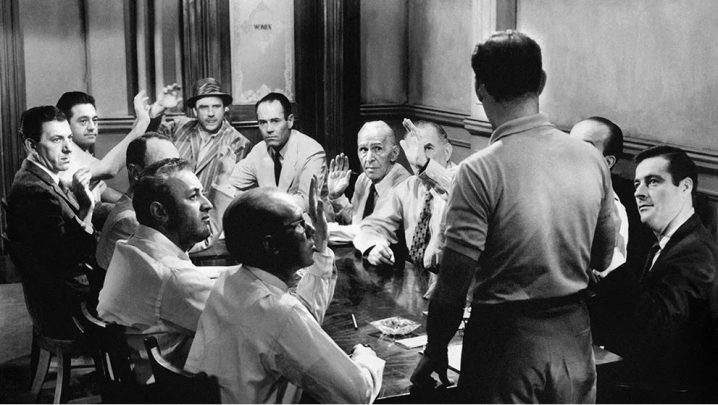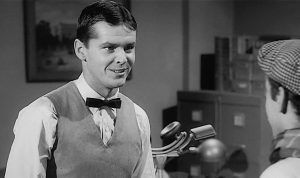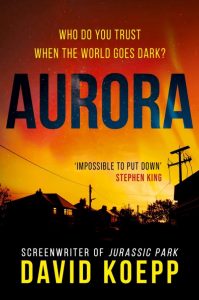
1924! The first Winter Olympics take place in the French Alps, and the Surrealist Manifesto is published in Paris. The Russian city of Petrograd becomes Leningrad. American president Calvin Coolidge pulls U.S. troops out of the Dominican Republic, and J. Edgar Hoover becomes director of the FBI. Adolf Hitler gets out of prison after his failed coup attempt the previous year. Astronomer Edwin Hubble proves that the Milky Way is just one of many galaxies in the universe.
In the movie business, Metro-Goldwyn-Mayer (MGM) is founded, and people are born all over the world who will eventually work wonders on the screen. Here are a few of them:
February 19 – Lee Marvin
White-haired, long-faced, ice-blooded Lee Marvin was so cool that some of the coolest people in entertainment today like to pretend he’s their dad: the “Sons of Lee Marvin” society includes near-lookalikes like Jim Jarmusch, Tom Waits, Nick Cave, Marvin’s two-time director John Boorman, and more. After serving in the Pacific Theater during World War II, Marvin began acting on stage and the small screen, finally making his film debut alongside Charles Bronson in 1951’s You’re in the Navy Now. War movies, the grittier the better, were Marvin’s bread and butter for most of his career, though he also found plenty of time for Westerns and crime movies. He could play pure villains, as he did for the title role of The Man Who Shot Liberty Valance opposite John Wayne and James Stewart, or gruff heroes and anti-heroes like the leader of The Dirty Dozen (1967) and a drunken gunfighter in Cat Ballou (1965). The latter performance earned him an Academy Award for Best Actor. Despite or perhaps because of his ultra-manly persona — he once wrote “there’s not ENOUGH violence on television” — Marvin also spoke out in favor of gay rights, against the Vietnam War, and on behalf of animal welfare. He died in 1987.
Lee Marvin’s Flickchart Top 5:
The Man Who Shot Liberty Valance (1962) – #108
The Big Heat (1953) – #369
The Dirty Dozen (1967) – #414
Point Blank (1967) – #781
The Big Red One (1980) – #1693
March 25 – Machiko Kyō
Machiko Kyō was probably the most in-demand Japanese actress of the 1950s, Japanese cinema’s golden age. She had, essentially, a triple role as the wife of the murdered samurai in Akira Kurosawa’s influential Rashomon (1950), which was much of the world’s introduction to Japanese movies. In a short span of time she acted for practically every big-name director of the day, appearing in Kenji Mizoguchi’s Ugetsu (1953), Kon Ichikawa’s Odd Obsession (1959), Yasujirō Ozu’s Floating Weeds (1959), and more, many of which critics still rank among the best movies of all time. Kyō often played cold or otherworldly types like murderesses, witches, and spirits, and frequently appeared in period-specific makeup and clothes; she excelled at projecting power and secretiveness simultaneously. She appeared in one American movie, 1956’s Teahouse of the August Moon starring Marlon Brando, and later in her career she made the jump to experimental New Wave movies, crowd-pleasing comedies, and television. Kyō died in 2019 at the age of 95.
Machiko Kyō’s Flickchart Top 5:
Rashomon (1950) – #42
Ugetsu (1953) – #212
Floating Weeds (1959) – #1047
Street of Shame (1956) – #5091
Gate of Hell (1953) – #6138
April 3 – Marlon Brando
Brando was the kind of star people referred to by a single name. “I knew Brando when…” and “Not since Brando has there been an actor like…” and “Do you prefer young Brando or old Brando?” He was also extremely imitable, with impersonations cropping up everywhere from Mel Brooks parodies to Disney movies to co-stars’ talk show appearances. And yet it is paradoxically difficult to determine the most Brando-like Brando role. Is it the alluring brute from A Streetcar Named Desire and the attractive rebel of The Wild One (1953), two performances that made him a sex symbol? Is it the smooth singer, dancer, and romancer of Guys and Dolls (1955)? Is it the makeup-encrusted, implicitly violent, yet curiously charismatic roles of Don Corleone in The Godfather (1972) and Colonel Kurtz in Apocalypse Now (1979)? Is it the smaller, almost cameo parts in which he more or less plays himself, like Superman’s alien father in Superman (1978)? With his reputation for being extremely difficult to work with, to the point of being abusive, it might be the problematic Last Tango in Paris (1972). Whichever Brando is your Brando, he was surely a powerful presence, just as he was a powerful absence when he famously declined to accept the Best Actor Oscar in 1973. Brando died in 2004 at the age of 80.
Marlon Brando’s Flickchart Top 5:
The Godfather (1972) – #3
Apocalypse Now (1979) – #59
On the Waterfront (1954) – #96
A Streetcar Named Desire (1951) – #370
Superman (1978) – #717
April 13 – Stanley Donen
A director of musicals whose top film on Flickchart is not a musical, Stanley Donen was a hoofer’s director with a thirst for originality. He got his start dancing and choreographing for the big screen, and once he moved to the director’s chair he shared responsibilities with Gene Kelly for a run of classics including Singin’ in the Rain (1952), a multiple Oscars nominee and fixture of many AFI Top 100 lists. Donen then went his own way and had several more successes, from the musicals Seven Brides for Seven Brothers (1954) and Funny Face (1957) to the crime farce Charade (1963). He continued working into the 1990s, but most of his later work fared less well, critically and commercially. Still, he was widely acknowledged as an important auteur of the musical genre; French New Wave director Jacques Demy modeled his style on Donen’s On the Town (1949), and a Donen-choreographed scene in Anchors Aweigh (1945) blended live action and animation in a way that was decades ahead of its time. The five-time-divorcee was partnered with Elaine May from 1999 until his death in 2019.
Stanley Donen’s Flickchart Top 5:
Charade (1963) – #181
Singin’ in the Rain (1952) – #226
On the Town (1949) – #1449
Funny Face (1957) – #1456
Two for the Road (1967) – #1834
April 16 – Henry Mancini
You can hear this picture, can’t you? It’s easy to overlook film composers in these lists, unless their music is as iconic as Henry Mancini’s. The son of Italian immigrants, Mancini began studying music because of a film score: the one Rudolph Kopp and other composers wrote for Cecil B. DeMille’s The Crusades (1935). Mancini wrote for Benny Goodman, took classes at Julliard, and served overseas in World War II where he helped liberate a concentration camp. His Hollywood career took off thanks to his work at Universal on films like Creature From the Black Lagoon and The Glenn Miller Story, both from 1954 — Mancini had actually worked with bandleader Glenn Miller, and his score for the biopic earned him his first of eighteen Academy Award nominations (with four wins to come). His best-remembered tunes, though, come from his long collaboration with director Blake Edwards: he did the music for Breakfast at Tiffany’s (1961), Victor Victoria (1982), and all of the Pink Panther movies from 1963-1993; “The Pink Panther Theme,” jazzy and playful and instantly recognizable, is surely one of the most-hummed songs of all time. Other credits by the prolific Mancini include music for Orson Welles, Walt Disney Studios, NBC Nightly News, and fellow 1924 baby Stanley Donen.
Henry Mancini’s Flickchart Top 5:
Touch of Evil (1958) – #63
Charade (1963) – #181
Breakfast at Tiffany’s (1961) – #521
Wait Until Dark (1967) – #384
A Shot in the Dark (1964) – #888
July 4 – Eva Marie Saint
Eva Marie Saint, born on the fourth of July, is still with us in her 100th year. She is a living link to another era of entertainment, to a time when you could start as an NBC page and a radio actress and work your way up to two Hollywood Walk of Fame stars (she has one for film and one for TV.) A winsome blonde type, her first film role was with Brando in On the Waterfront, which won her an Academy Award for Best Supporting Actress. Hitchcock tried to make her a bit colder, or at least huskier, in 1959’s North by Northwest opposite Cary Grant, and in 1965 she deepened her thriller resume with the Hitchcockian 36 Hours alongside James Garner. After that she carved out a steady niche in film and TV comedies, with the odd drama, western, or horror along the way. Highlights of big and small screen include The Russians are Coming, the Russians are Coming! (1966), a star-studded TV adaptation of How the West Was Won, several Bob Hope vehicles, stints on The Love Boat and Frasier, and a voice role in The Legend of Korra. By odd coincidence, like her birth year fellow Marlon Brando, Saint eventually played one of Superman’s parental figures, appearing as Ma Kent in 2006’s Superman Returns. Happy 100th birthday, Eva!
Eva Marie Saint’s Flickchart top 5:
North by Northwest (1959) – #37
On the Waterfront (1954) – #96
Titanic (1996 TV movie, not the James Cameron movie from 1997) – #3345
Exodus (1960) – #4643
Grand Prix (1966) – #5535
June 25 – Sidney Lumet
One of the great moralists of moviedom, director Sidney Lumet hit his stride a little later than most people on this list. His character-driven studies in ego, desperation, and injustice belong mainly to the New Hollywood movement of the late 1960s and 1970s, and they spotlighted some of the most intriguing stars of that grim, grimy, ambitious moment: Al Pacino in Serpico (1973), and Dog Day Afternoon (1975), Faye Dunaway in Network (1976), Paul Newman in The Verdict (1982). Though he was an American, Lumet also worked frequently in the U.K. and with its leading actors, making multiple movies with Sean Connery and Albert Finney; their Murder on the Orient Express from 1974 remains one of the best Agatha Christie adaptations. Nonetheless, it is Lumet’s very first feature that tops his Flickchart: 1957’s 12 Angry Men is a single-location masterpiece of escalating tension, passionate monologues, and big, important questions. The lesser-known Fail-Safe (1964), based on the same story as Dr. Strangelove from the same year, is even more extreme in its exploration of a momentous ethical quandary. A genre departure later in Lumet’s career, the movie version of the Broadway musical The Wiz (1978), still speaks to social issues by situating The Wizard of Oz’s story in majority-Black Harlem. Lumet’s final film, the crime drama Before the Devil Knows You’re Dead, came out in 2007, four years before his death in 2011 at the age of 86.
Sidney Lumet’s Flickchart Top 5:
12 Angry Men (1957) – #53
Network (1976) – #101
Dog Day Afternoon (1975) – #178
Fail-Safe (1964) – #469
Serpico (1973) – #500
August 15 – Robert Bolt
British playwright and screenwriter Robert Bolt’s short list of credits is like a crash course in important movies. He won back-to-back writing Oscars for Doctor Zhivago (1965) and A Man for All Seasons (1966), helping to make up for a near miss with Lawrence of Arabia a few years earlier. Bolt again partnered with Lawrence and Zhivago director David Lean for Ryan’s Daughter (1970), and he wrapped up his career highlights with 1986’s The Mission, another much-honored movie that Bolt adapted from his own full-length novel. Not content with writing some of the most profound movies of his generation, Bolt also tried his hand at directing; he cast his wife, actress Sarah Miles, in Lady Caroline Lamb (1972), which appropriately enough is the story of a novelist. That movie was professionally unsatisfying for all concerned, and perhaps the stress of it contributed to a heart attack and stroke that left Bolt paralyzed later that decade. He recovered enough to produce several more works before his death in 1995, but it’s the unfinished and unadapted ones that most fire the imagination: a Wrinkle in Time adaptation for Norman Lear, a biopic about the Buddha, movies about Galileo, polar explorers, America’s Founding Fathers…
Bolt’s style of writing and choice of subjects can seem inflated and self-important by today’s standards, but in truth his screenplays are still provocative and subversive and defy easy summary. They take big historical figures and situations and consider them from all sides, eschewing easy takeaways in favor of more sagacious uncertainties. In Lawrence, mourners at the title character’s funeral express different opinions about the nature of the departed legend, and all of them are to some extent correct. In Ryan’s Daughter the closing lines come from a priest, played by Trevor Howard: “Well, maybe you’re right… but I doubt it. And that’s my parting gift to you. That doubt!” What a gift Bolt gave movie fans.
Robert Bolt’s Flickchart Top 5:
Lawrence of Arabia (1962) – #172
A Man for All Seasons (1966) – #725
Doctor Zhivago (1965) – #794
The Mission (1986) – #1402
The Bounty (1984) – #2294
September 16 – Lauren Bacall
Initially famous as the wife of Humphrey Bogart and co-manager, with him, of the original Rat Pack, Lauren Bacall’s full filmography easily holds its own. She came to prominence alongside Bogey in a slew of top-shelf noir pictures, but in some cases it was her who contributed the biggest moments; when people discuss To Have and Have Not (1944), it’s Bacall’s “You know how to whistle, don’t you?” line that they’re usually talking about. She was statuesque, sultry, rich-voiced (her screen voice, like Bogart’s, was a put-on that strained their vocal chords), and seemingly always up for a fight. Outside of her work with Bogart, How to Marry a Millionaire (1953) matched her with Marilyn Monroe, Douglas Sirk cast her in his drama Written on the Wind (1956), and she faced off with Gregory Peck in Vincente Minnelli’s Designing Women (1957). After Bogart’s death in 1957, Bacall’s career continued, and unlike a lot of leading ladies she kept getting good roles as she aged. She acted for another member of this list, Sidney Lumet, in Murder on the Orient Express in 1974, and John Wayne picked her to appear in what would be his final film, The Shootist (1976), despite their vastly different politics. Appearances in hits like Misery (1990) and a voice performance in the English dub of Howl’s Moving Castle (2004), the highest-grossing anime to that time, kept Bacall relevant to new generations of fans. She died in 2014 at the age of 89.
Lauren Bacall’s Flickchart Top 5:
The Big Sleep (1944) – #125
Key Largo (1948) – #325
To Have and Have Not (1944) – #386
Misery (1990) – #785
The Shootist (1976) – #1023
September 24 – Marcello Mastroianni
The face of Italian movies during their artistic peak, Marcello Mastroianni found enormous global success by reflecting the postwar sensibilities of continental Europe. He was a Cassanova — actually, he played Cassanova in La Nuit de Varennes — with a wry grin and thoughtful, smiling eyes with which to beguile the likes of Sophia Loren, Anita Ekberg, and Brigitte Bardot. Mastroianni first hit the big time with the crime comedy Big Deal on Madonna Street (1958), then partnered with his visionary countrymen Federico Fellini and Michaelangelo Antonioni for the massively acclaimed films La Dolce Vite (1960), La Notte (1961), and 8 ½ (1963). In these and other monuments of mid-century malaise, he burns through women like cigarettes, pausing between puffs to peer over his sunglasses at the changing landscapes of western Europe, his brow perpetually furrowed in mild bemusement. He was cool cosmopolitanism personified. Mastroianni’s personal life was not too far removed from his womanizing screen persona; he had well-publicized relationships with actresses Faye Dunaway and Catherine Deneuve, among others. After his death in 1996, a number of his exes banded together to try to stop the release of a documentary about him at the Cannes Film Festival, but it screened anyway. It had to, there was always a Mastroianni film at Cannes, and he still shares the record for most Best Actor wins there. European cinema hasn’t been the same without him.
Marcello Mastroianni’s Flickchart Top 5:
8 ½ (1963) – #97
La Dolce Vita (1960) – #120
La Notte (1961) – #1059
Big Deal on Madonna Street (1958) – #2756
Divorce Italian Style (1961) – #2806
Other film and TV personalities to celebrate in their centenaries this year include Katy Jurado, Dorothy Malone, Colleen Dewhurst, Jane Greer, Cicely Tyson, Sergei Parajanov, Theodore Bikel, Charles Aznavour, Pat Hingle, Don Knotts, Leslie Phillips, Rod Serling, Maurice Jarre, Buddy Hackett, and Hideko Takamine. Writers Christopher Tolkien, James Baldwin, and Truman Capote, whose work has provided the basis for many important media properties, each would have turned 100 this year as well. Cheers to all of them!




